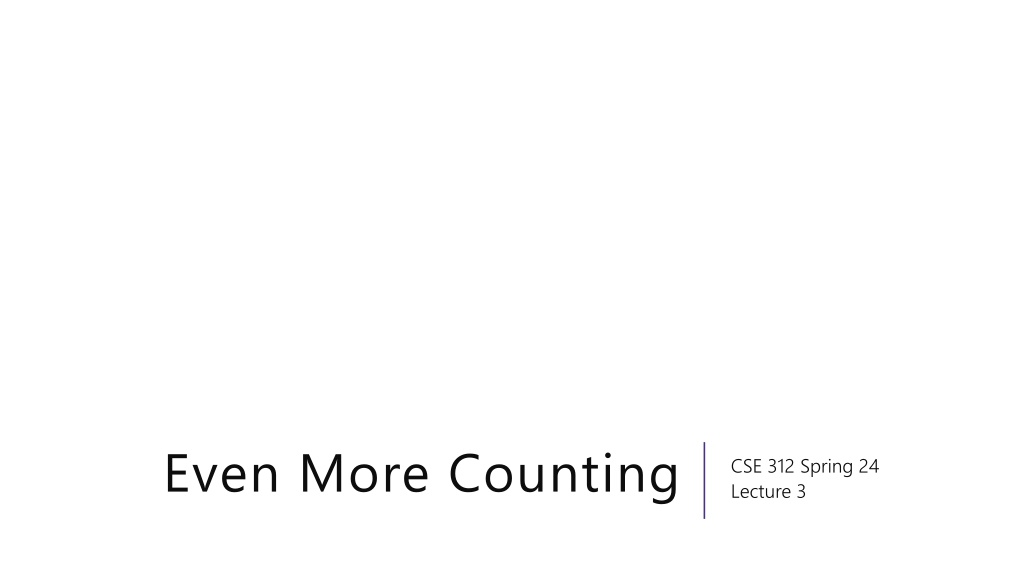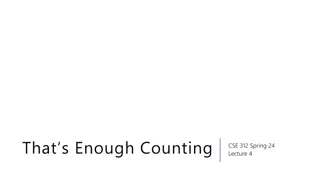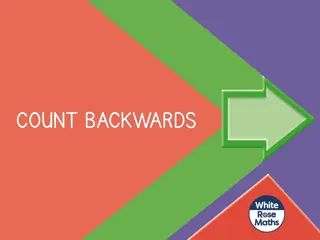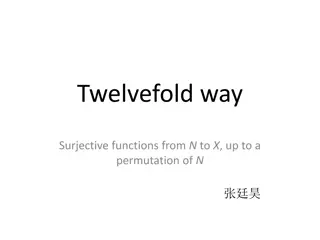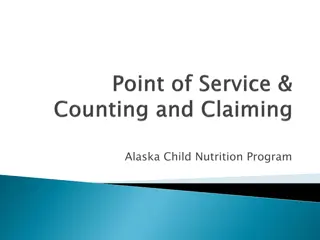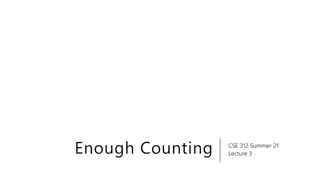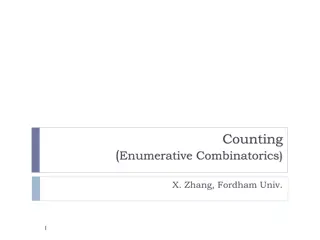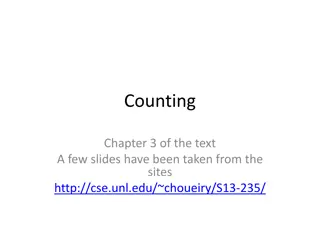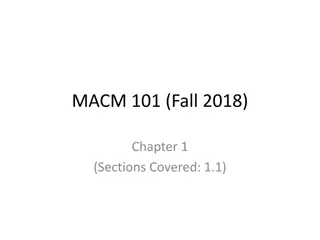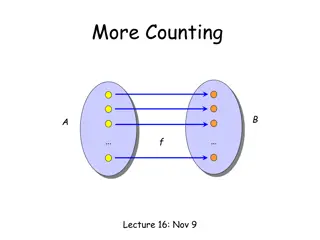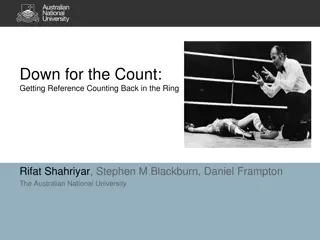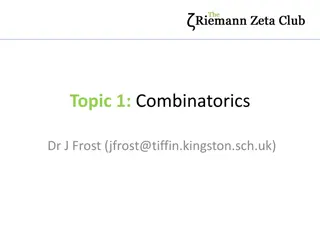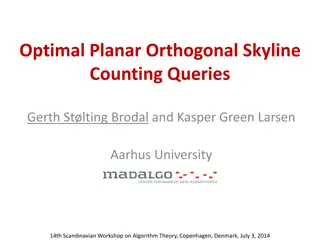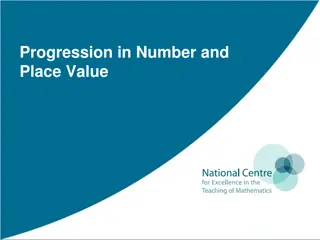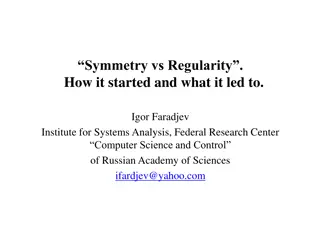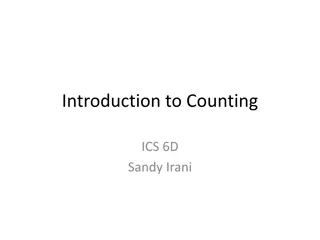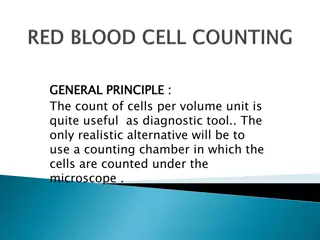Counting Techniques and Combinatorics Overview
Explanation of counting principles in combinatorics including permutations, combinations, binomial theorem, and overcounting scenarios with examples like anagrams. Also covers important facts and rules related to combinations. Highlights the importance of starting homework early and accessing optional online resources for a different perspective.
Download Presentation

Please find below an Image/Link to download the presentation.
The content on the website is provided AS IS for your information and personal use only. It may not be sold, licensed, or shared on other websites without obtaining consent from the author. Download presentation by click this link. If you encounter any issues during the download, it is possible that the publisher has removed the file from their server.
E N D
Presentation Transcript
Even More Counting CSE 312 Spring 24 Lecture 3
Announcements HW 1 is out! Due Wednesday. Office hours started yesterday! Visit now before others start on the homework. Also, please start on the homework early.
Announcements There s an optional (online) textbook. It s linked on the webpage (under the resources tab). Useful if you want a different perspective. Occasional differences in notation/vocabulary, but still useful!
Outline So Far Sum and Product Rules Combinations (order doesn t matter) and Permutations (order does matter) Introduce ordering and remove it to make calculations easier This Time Some Proofs by counting two ways Binomial Theorem Principle of Inclusion-Exclusion
Overcounting How many anagrams are there of SEATTLE (an anagram is a rearrangement of letters). It s not 7! That counts SEATTLE and SEATTLE as different things! I swapped the Es (or maybe the Ts)
Overcounting How many anagrams are there of SEATTLE Pretend the order of the Es (and Ts) relative to each other matter (that SEATTLE and SEATTLE are different) How many arrangements of SEATTLE? 7! How have we overcounted? Es relative to each other and Ts relative to each other 2! 2! Final answer 2! 2! 7!
Overcounting How many anagrams are there of GODOGGY?
Overcounting How many anagrams are there of GODOGGY? 7! 2!3! One more piece of notation multinomial coefficient 7! 2,3is alternate notation for In general: ?1,?2, ,? Popular notation among mathematicians. 2!3!. ?! 7 ? = ?1! ?2! ? !
Some Facts about combinations Symmetry of combinations: ? ? ?= ? ? Pascal s Rule: ? ? 1 ? 1+ ? 1 ? ?=
Two Proofs of Symmetry Proof 1: By algebra ?! ? ?= Definition of Combination ?! ? ? ! ?! = Algebra (commutativity of multiplication) ? ? !?! ? Definition of Combination = ? ?
Two Proofs of Symmetry Wasn t that a great proof. Airtight. No disputing it. Got to say commutativity of multiplication. But do you know why? Can you feel why it s true?
Two Proofs of Symmetry Suppose you have ? people, and need to choose ? people to be on your team. We will count the number of possible teams two different ways. Way 1 Way 1: We choose the ?people to be on the team. Since order doesn t matter (you re on the team or not), there are ? Way 2 Way 2: We choose the ? ? people to NOT be on the team. Everyone else is on it. Since order again doesn t matter, there are ways to choose the team. Since we re counting the same thing, the numbers must be equal. So ? ?= ? possible teams. ? ? possible ? ? ?. ?
Pascals Rule: ? ?= ? 1 ? 1+ ? 1 ?
Pascals Rule: ? ?= ? 1 ? 1+ ? 1 ? You and ? 1 other people are trying out for a ? person team. How many possible teams are there? Way 1 Way 1: There are ?people total, of which we re choosing ?(and since it s a team order doesn t matter) ? Way 2 Way 2: There are two types of teams. Those for which you make the team, and those for which you don t. If you do make the team, then ? 1 of the other ? 1 also make it. If you don t make the team, ? of the other ? 1 also make it. Overall, by sum rule, ? 1 ? 1+ ? Since we re computing the same number two different ways, they must be equal. So: ? ?= ? ?. . ? 1 ? 1 ? 1+ ? 1
Takeaways Formulas for factorial, permutations, combinations. A useful trick for counting is to pretend order matters, then account for the overcounting at the end (by dividing out repetitions) When trying to prove facts about counting, try to have each side of the equation count the same thing. Much more fun and much more informative than just churning through algebra.
Binomial Theorem In high school you probably memorized ? + ?2= ?2+ 2?? + ?2 And ? + ?3= ?3+ 3?2? + 3??2+ ?3 The Binomial Theorem tells us what happens for every ?: The Binomial Theorem ? ? ? ? + ??= ???? ? ?=0
Some intuition The Binomial Theorem ? ? ? ? + ??= ???? ? ?=0 Intuition: Every monomial on the right-hand-side has either ? or ? from each of the terms on the left. How many copies of ???? ? do you get? Well how many ways are there to choose ?? s and ? ? ? s? ? Formal proof? Induction! ?.
So What? Well if you saw it before, now you have a better understanding now of why it s true. There are also a few cute applications of the binomial theorem to proving other theorems (usually by plugging in numbers for ? and ?) you ll do one on HW1. For example, set ? = 1 and ? = 1 then 2?= 1 + 1?= ?=0 i.e. if you sum up binomial coefficients, you get 2?. Exercise: reprove this equation (directly) with a combinatorial proof (where have we seen 2? recently?) ? ?. ? ?1?1? ?= ?=0 ? ?
Example How many length 5 strings over the alphabet {?,?,?, ,?} contain: Exactly 2 a s OR Exactly 1 b OR No x s For what ?,?,? do we want |? ? ?|?
Principle of Inclusion-Exclusion The sum rule says when ? and ? are disjoint (no intersection), then ? ? = ? + |?|. What about when ? and ?aren t disjoint? ? ? ? ? For two sets: ? ? = ? + ? |? ?|
Principle of Inclusion-Exclusion For three sets: ? ? ? = ? + ? + ? ? ? ? ? ? ? + |? ? ?|
Example How many length 5 strings over the alphabet {?,?,?, ,?} contain: Exactly 2 a s OR Exactly 1 b OR No x s For what ?,?,? do we want |? ? ?|?
In general: ?1 ?2 ?? = ?1+ ?2+ + ?? ?1 ?2+ ?1 ?3+ + ?1 ??+ ?2 ?3+ + ?? 1 ?? +( ?1 ?2 ?3+ + ?? 2 ?? 1 ??) + 1?+1|?1 ?2 ??| Add the individual sets, subtract all pairwise intersections, add all three-wise intersections, subtract all four-wise intersections, , [add/subtract] the ?-wise intersection.
How many length 5 strings over the alphabet {?,?,?, ,?} contain: Exactly 2 a s OR Exactly 1 b OR No x s Example ? = {length 5strings that contain exactly 2 a s} ? = {length 5strings that contain exactly 1 b s} ? = {length 5strings that contain no x s } 5 2 253(need to choose which spots are a and remaining string) 5 1 254 ? = 255 ? = ? =
How many length 5 strings over the alphabet {?,?,?, ,?} contain: Exactly 2 a s OR Exactly 1 b OR No x s Example 5 2 253 5 1 253 ? = {length 5strings that contain exactly 2 a s} ? = {length 5strings that contain exactly 1 b s} ? = {length 5strings that contain no x s } ? = ? = ? = 255 3 1 242(choose a spots, b spot, remaining chars) 5 2 5 2 243(choose a spots, remaining [non- x ] chars) 5 1 244 5 2 ? ? = ? ? = ? ? = ? ? ? = 3 1 232(choose a spots, b spot, remaining [non- x ] chars)
How many length 5 strings over the alphabet {?,?,?, ,?} contain: Exactly 2 a s OR Exactly 1 b OR No x s Example 5 2 253 5 1 254 ? = ? = ? = 255 ? ? ? = = ? + ? + ? ? ? ? ? ? ? + |? ? ?| =5 =11,875,000 ? ? ? ? ? ? + ? ? ? = 11,875,000 2 = 11,875,000 1,814,400 + ? ? ? = 10,060,600 + |? ? ?| = 10,060,600 + 2 = 10,060,600 + 15,870 = 10,076,470 2 253+ 5 1 254+255 ? ? ? ? ? ? + ? ? ? 5 2 5 2 243 5 1 244 3 1 242 ? ? = 5 3 1 242 5 2 243 5 1 244+ ? ? ? ? ? = 5 3 1 232 ? ? = 5 2 3 1 232 ? ? ? =
Practical tips Give yourself clear definitions of ?,?,?. Make a table of all the formulas you need before you start actually calculating. Calculate size-by-size and incorporate into the total. Basic check: If (in an intermediate step) you ever: 1. Get a negative value 2. Get a value greater than the prior max by adding (after all the single sets) 3. Get a value less than the prior min by subtracting (after all the pairwise intersections) Then something has gone wrong.
Pigeonhole Principle If you have 5 pigeons, and place them into 4holes, then At least two pigeons are in the same hole.
Pigeonhole Principle If you have 5 pigeons, and place them into 4holes, then At least At least two pigeons are in the same hole. It might be more than two.
Strong Pigeonhole Principle If you have ? pigeons and ? pigeonholes, then there is at least one pigeonhole that has at least ? ? pigeons. ?is the ceiling of ? (it means always round up, 1.1 = 2, 1 = 1).
An example If you have to take 10 classes, and have 3 quarters to take them in, then Pigeons: The classes to take Pigeonholes: The quarter Mapping: Which class you take the quarter in. Applying the (generalized) pigeonhole principle, there is at least one quarter where you take at least 3 10 = 4 courses.
Practical Tips When the pigeonhole principle is the right tool, it s usually the first thing you d think of or the absolute last thing you d think of. For really really tricky ones, we ll warn you in advance that it s the right method (you ll see one in the section handout). When applying the principle, say: What are the pigeons What are the pigeonholes How do you map from pigeons to pigeonholes Look for a set you re trying to divide into groups, where collisions would help you somehow.
